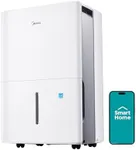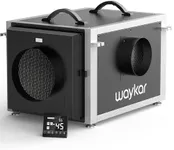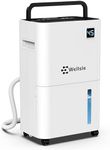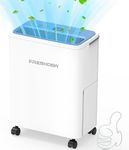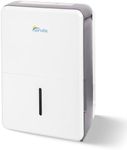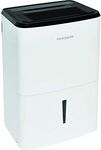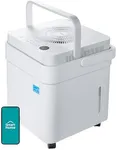Buying Guide for the Best Dehumidifier In Canada
Choosing a dehumidifier is all about matching the device to your space and your needs. Dehumidifiers help remove excess moisture from the air, which can prevent mold, reduce allergens, and make your home more comfortable. When shopping for a dehumidifier in Canada, it's important to consider the climate, the size of the area you want to dehumidify, and any specific features that might make operation easier or more effective for your situation. Understanding the key specifications will help you make a choice that keeps your home dry and healthy.Capacity (Pints per Day)Capacity refers to how much moisture a dehumidifier can remove from the air in a 24-hour period, usually measured in pints. This is important because it determines how effective the unit will be in your space. Smaller units (20-30 pints) are suitable for small rooms or mild dampness, medium units (30-50 pints) work well for medium-sized rooms or moderate dampness, and larger units (50+ pints) are best for basements, large rooms, or very damp conditions. To pick the right capacity, consider both the size of the area and how wet it tends to get—bigger, wetter spaces need higher capacity.
Room Size CoverageRoom size coverage tells you the maximum area the dehumidifier is designed to handle, usually given in square feet or square meters. This is important because a unit that's too small for your space won't be effective, while one that's too large may use more energy than necessary. Manufacturers often provide guidelines for room size, so measure your space and choose a dehumidifier that matches or slightly exceeds that area for best results.
Energy EfficiencyEnergy efficiency indicates how much electricity the dehumidifier uses to remove moisture. This is important for keeping your energy bills in check, especially if you plan to run the unit often. Look for models with energy-saving certifications or features like auto-shutoff and programmable timers. If you expect to use your dehumidifier frequently or for long periods, prioritizing energy efficiency will save you money and reduce environmental impact.
Drainage OptionsDrainage options refer to how the collected water is removed from the dehumidifier. Some units have a removable bucket that you empty manually, while others offer continuous drainage through a hose. This is important for convenience—if you don't want to empty a bucket often, look for a model with a hose connection or a built-in pump for automatic drainage. Think about where you'll place the dehumidifier and how often you're willing to empty it to decide which drainage method suits you best.
Noise LevelNoise level describes how loud the dehumidifier is when running, usually measured in decibels (dB). This matters if you plan to use the unit in a bedroom, living room, or other quiet space. Lower noise levels (below 50 dB) are best for bedrooms or offices, while higher levels may be acceptable in basements or utility rooms. Consider where you'll use the dehumidifier and how sensitive you are to noise when making your choice.
Operating Temperature RangeOperating temperature range tells you the temperatures at which the dehumidifier works effectively. This is especially important in Canada, where basements and garages can get quite cold. Some dehumidifiers are designed to work in lower temperatures and have features like auto-defrost to prevent freezing. If you need to dehumidify a cool space, make sure to choose a model rated for low-temperature operation.
Filter Type and MaintenanceThe filter in a dehumidifier helps trap dust and allergens, improving air quality. Some filters are washable and reusable, while others need to be replaced regularly. This is important for both air quality and maintenance—washable filters are more convenient and cost-effective, while replaceable filters may offer better filtration. Consider how much maintenance you're willing to do and whether air purification is a priority for you.



